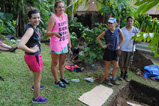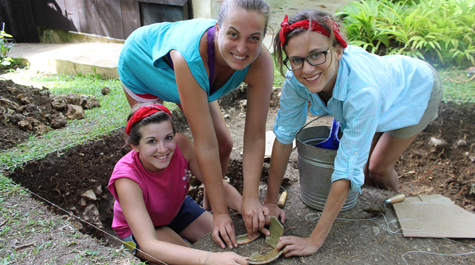W&M students uncover clues to Barbadian history
Since 2006, Smith has brought W&M undergraduate and graduate students to Barbados to work alongside Barbadian students in archaeological research. This past summer, they spent a month digging around the outbuildings of the St. Nicholas Abbey sugar plantation.
“The Barbados study abroad program is intended to offer archaeological training within the context of a cross-cultural experience,” explained Smith. “William & Mary students are immersed in Barbadian society, working with local historians, students from the University of the West Indies, local volunteers, workers on the estate and many other Barbadians.”
For Garnet Fryling ’14, an anthropology major, this immersion is a highly-prized aspect of the program.
“The most exciting thing has been getting out and interacting with the locals,” she said. “I’ve made great friends and gotten a chance to understand the culture on a new level.”
Fryling and five other undergraduate and graduate students spent the month of July with Smith uncovering artifacts and architectural evidence that provide clues about the types of activities that occurred in the plantation’s outbuildings.
 “The presence of domestic tableware at the dig site suggests that maybe one of the buildings served as a dwelling for the plantation manager and his family,” said Smith. “We believe that skilled work took place in the adjacent building, which perhaps served as a blacksmith shop or cooperage where barrels were made.”
“The presence of domestic tableware at the dig site suggests that maybe one of the buildings served as a dwelling for the plantation manager and his family,” said Smith. “We believe that skilled work took place in the adjacent building, which perhaps served as a blacksmith shop or cooperage where barrels were made.”Smith and his students are also very interested in the lives of enslaved workers on the estate. In previous summer programs they have searched for and found the location of two early 18th century slave villages on the plantation. The materials they unearthed have helped shed light on the lives and material conditions of enslaved workers.
Smith and students found cowry shells, which were probably used as necklaces or other forms of adornment, as well as gaming pieces made from broken bits of pottery, which were probably used for playing a West African game called warri. The presence of these gaming pieces is an example of the way enslaved peoples on Barbadian sugar estates maintained West African traditions in their New World setting.
Smith, and other archaeologists of the African Diaspora, are often interested in finding evidence of the types of West African practices and activities that survived the Middle Passage and continued on in the plantations in Barbados and elsewhere in the Americas.
This past summer, Smith and his students investigated the caves and gullies around St. Nicholas Abbey. According to Smith, caves served as meeting places where enslaved people from surrounding plantations would gather. They may have served as secretive spaces where enslaved people could relax outside of the view of the planter class.
Smith’s earlier work shows that alcohol drinking was one of the primary activities that occurred in these caves, which suggests that they probably served as clandestine meeting places used by groups of enslaved workers from nearby villages to escape the challenges of plantation life.
Smith, who has conducted fieldwork in Barbados for nearly 20 years and considers the island his adopted home, sees his work as raising awareness of Barbados’ contributions to the modern Atlantic world, to an understanding of how slavery and colonialism shaped the island’s identity, and to promoting heritage tourism in the island.
“I love doing archaeological excavations and working hands-on with the students doing original research and uncovering new finds about Barbados,” said Smith. “It is investigative work and we are all detectives in our own way. My former students always comment to me later in life how their experiences in Barbados opened their eyes to new ways of thinking about the world.”

















